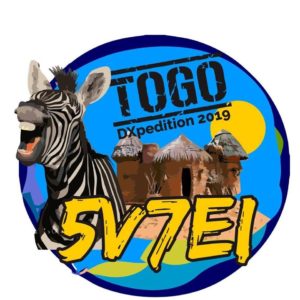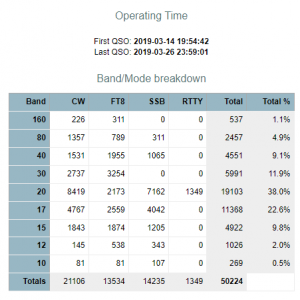In January of this year I was going about my daily business when I received a phone call from Dave Deane EI9FBB. Dave is the DXpedition leader for the EIDX group. He explained to me that circumstances had changed, and they had extra availability and a seat on the plane had freed up. This was off the back of a conversation we had at the RSGB convention last October. This was the first time I has been invited on a large scale DXpedition with an experienced team. Of course, I had to think of the implications and preparations I would have to undergo for a trip like this at short notice, but after a few hours I made another call to Dave to accept the kind offer.
Some of the preparations involved Getting the required vaccines and Anti-Malaria tablets, finding the best mosquito repellents, packing a very small suitcase that could go with me as hand luggage, and getting myself to Paris, Charles de Gaulle, where I would meet the team. I flew to Paris a day prior to the biggest part of the team’s arrival, where I met Alain F5JTV who would also join us on the DXpedition. With an entire day free what better opportunity to explore Paris and do some of the ‘touristy’ things in one of Europe’s biggest cities. That evening the rest of the team arrived, and after spending some time introducing myself to everyone we all retired to our hotel rooms not far away from the airport.
The next day I realised the challenges of DXpedition with airline restrictions, as we checked in. All 500kg of luggage was divided among 12 of the team members, whilst the rest carried personal equipment. And after a short wait in CDG airport we boarded our flight to Lomé, Togo.
Upon arrival we were met by the Togolese Border control, where we then proceeded to get our Visa’s and collect our luggage. As you can imagine, a team of 14 people with over 500kg’s of luggage would draw some attention. And sure enough we were stopped for security checks. The aspects of Radio and DXpeditioning took some explaining but once the Togolese customs were satisfied we were on our way.
The trip from the airport to our hotel took about 20 minutes by taxi, by the time we arrived it was dark. It gave the team leaders a chance to map out where we would put the verticals, and more importantly where we would put the hex beams. But it wasn’t practical to start building our antenna farm that night.
The next morning during breakfast it was discussed where antennas would go and how we would execute the erection of an antenna farm. The full set of vertical dipoles were located along a fence that ran across the beach at the front of our hotel complex. The 160/80m antenna was over 100m away at the opposite end of the beach. One hex beam was located behind our apartments and the other in a neighbouring beach.
With a plan in place we were able to get to work. The group split into teams, tasked with different jobs to get the station up and running. My job, along with Thos EI2JD, Alain EI2KM/F8FUA and Declan EI9HQ was to erect the SSB Hex beam. This would be located behind the apartments and be the main antenna used by the SSB operators. Meanwhile other team members started to build vertical antennas and assemble the shacks. By the first evening after arrival we had enough antennas up to become QRV on all stations. Over the week we added to our array until we were QRV on all bands 160-10m (Excluding 60m).
When we went QRV all station started at one time as discussed prior to the DXpedition. Pile ups to start were quite big, but generally well behaved for the first day. As an experienced contester and having operated from several big stations, I am no stranger to a pile up. I even consider myself to be good at running them. However as with every new adventure there is a learning curve. Firstly, the challenge was to just give a signal report, purely from habbit I always want to give a Zone or number or some sort. So, I had to nip that in the bud straight away. The other challenge was working split and turning the VFO. Listening up 5 to 10 requires this skill. Fine tuning across the QSX area to find the next station to work.
The first night on 40m was awesome! With a loud opening to Japan and North America. However, we suffered horrendous noise. Come morning we had to investigate the QRM. And after turning various things on and off we found a security light on the beach was causing S9+20 noise. The hotel was kind enough to let us turn it off. Great! We were up and running again with lower noise.
Over the next days following we noticed some noise on some of the higher bands. Our solution to this was moving the antennas closer to the ocean and away from the hotel. This helped with the QRM but made another problem for us to contend with. To anchor our antenna poles we used Woven shopping bags filled with rocks and sand. When the tide came in the bags went out, Over the space of a week we lost a few poles to the sea, Luckily the inland anchors stopped them being swept out. So, we were able to retrieve and repair. Our quick fix for the poles was duct tape, and the solution to the anchor bags being swept out to sea was to bury them in the sand. Whilst this didn’t stop the sand around them being washed away, it did slow the process down. We ended up re-burying the bags every day or two.
During our stay in Togo we were visited by two representatives of the telecommunications and licensing authority. They brought us documents for licensing and wanted a shack tour. We were more than happy to oblige. They were interested to hear the pile ups and get a better understanding of our activities. I was called over by EI2KM to greet them as the youngest team member. They told me it’s unusual to see an operator my age on a Ham radio DXpedition. After some photos with the representatives and our team leaders they went on their way.
Conditions through the time we were there deteriorated. QSB was deep and running pile ups got very tough. During this time our FT8 operators came into their element. Keeping rate going when SSB and CW were not producing any QSO’s. The whole FT8 debate is a controversial one as many people know. But love it or hate it, it does work! We managed to keep up a good rate during times that “Conventional modes” could not. This proved very useful during our stay in Togo and made up over 13 000 of our total contacts made.
We ran right up until the last minute, Leaving as many stations on as practical until the last minute. On the last day all the verticals were taken down, cleaned and packed away. One of the Hex beams was taken down and the shacks were dismantled little by little. By the time we had finished taking down the verticals, we still had one station going with the other Hex beam. And when the decision was made to go QRT all operators helped around the shack and antenna site. The final hex beam was taken down and packed away. All litter cleared from the beach and we staged our bags at the hotel restaurant. Our anchor bags and Some basic tools were donated to local fisherman along with the used guy ropes we had coiled up.
The last motion was to have a meal and team meeting before the long trip back to our various home countries. We all listened those who wanted to say something and had a small presentation where each operator was given a plaque with the DXpedition logo and our name/callsign on, together with other souvenirs.
Overall the 5V7EI DXpedition was a success. Whilst at the airport waiting to depart the final logs were uploaded to club log and our statistics were in. We had beat our target of 50k QSO’s and made 50 224 contacts in total. Europe made up the largest percentage of 63.8%, whilst NA was second highest and made up 19% of our total contacts.
My first DXpedition experience was a good one! I was welcomed into the team with open arms. I learned a lot about how to conduct a team DXpedition and different methods of doing working the problem and finding solutions. I was able to visit a new country, work some big pile ups and most importantly make some new ham friends and colleagues. I would like to thank team leaders Dave EI9FBB and Jeremy EI5GM for inviting me on this trip and introducing me to the EIDX group. And a thank you to all the team members who gave me a memorable trip and for helping me along the way.
73, Jamie M0SDV. 5V7EI Team member


